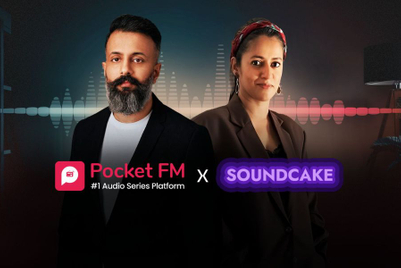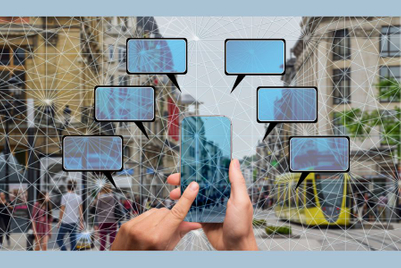.jpg&h=570&w=855&q=100&v=20250320&c=1)
The world of marketing has been dominated by visuals—from images to videos—for decades. Even the short videos, reels, and memes that became popular recently—marketing communication primarily meant visual communication.
Not anymore. Audio is taking over, slowly but steadily. The resurgence of audio is still understated but powerful. Consumers, in general, are shifting rapidly to audio-led entertainment, and that, in turn, is redefining brand marketing and advertising.
Audio on the growth path
There are many reasons why marketers have started recognising the strategic importance of audio in the marketing mix. No longer confined to screens, this media is becoming the new video in the world of entertainment.
The shift in preferences seems to have occurred post-Covid. Lockdowns forced people to stay confined to their homes and computer and mobile screens for work, education, and entertainment. Excessive screen time during that period also led to a screen fatigue for many.
Global consulting firm Bain & Company sums it up in a blogpost: “Lines between media types are disappearing, consumers are creators, and entertainment is daubing tech and retail all over itself. Content is ever present, consistent across platforms, and individually personalised. As our physical world blends with virtual worlds, entertainment realities are changing, too… Investment capital is flowing into start-ups and new technologies to meet the evolving demands of media and entertainment consumers.”
With consumers shifting to audio as a preferred mode of entertainment, marketers have to add audio into their marketing mix, offering brands new avenues to reach and engage with their audiences.
Reach and emotional connect
The proliferation of diverse audio platforms such as Spotify, Pocket FM, and Clubhouse offers brands multiple channels to reach different demographics across income-, language-, and age-groups.
Audio brings the convenience of multi-tasking allowing people to consume audio content while commuting or exercising or carrying out the chores. Increasing the touchpoints, this can potentially keep brands top-of-mind throughout the day.
The aural channel can also build emotional connections with consumers through voice, music, and sound effects. According to an Audio Publishers Association study, 73% of podcast listeners in India feel a deeper connection with brands that advertise on their favourite shows. This connection is further amplified through storytelling—an approach where brands can foster loyalty and trust by resonating deeply with their audience.
Take the example of Mahindra & Mahindra’s (M&M) ‘Rise’ campaign. With a series of audio stories about real-life achievers, M&M easily connected with the target audience emotionally and reinforced its ethos of driving a positive change.
M&M’s campaign has shown how audio storytelling can be far more personal and impactful than visual advertisements. That’s because audio touches the imaginations and emotions of listeners more than visual advertisements.
Riding the airwaves
Importance of audio is poised to increase considerably in the near future. A Redseer study released in February 2024 reveals a hockey-stick growth of audio series as a category. “With 1.3 billion addressable users for audio series globally, 2023 accounted for $21-25 billion global opportunity, and the value is projected to grow 2X in the next five years,” it noted.
The study also added that audio series, with its 24x7 entertainment has a greater engagement potential compared to other audio streaming services. With its ability to address untapped use-cases, the market is expected to continue expanding. Over the last two years, audio series is expected to have grown at a CAGR of 640 percent translating to over 40X growth from 2021 to 2023.
Naturally, marketeers will have to include audio into their brand marketing communications going forward. Similar to how logos are vital for brand recognition, audio elements such as jingles, sound logos, and signature voiceovers play a major role in enhancing brand recall. Regular exposure to audio elements reinforces brand identity, aiding brand recall.
Airtel’s signature tune is a good example. The AR Rahman-composed tune has become synonymous with the brand itself. The intro sound of Netflix is another example. Just like visual logos, these signature sounds help build brand equity.
Averting a crisis
Since video content is generally more expensive than audio content, video-led marketing campaigns are costlier than audio campaigns. This makes audio campaigns appealing to budget-conscious brands aiming for wide reach and high frequency.
Audio can be particularly relevant in India’s diverse and vast market of urban and rural consumers. Audio’s lower production costs and extensive reach may help brands penetrate deeper into rural areas, where radio and audio-streaming services have a higher subscriber base than visual media.
Lastly, audio also plays a crucial role in crisis communication. Brands need to maintain continuous and reliable presence when in crisis, and audio provides a direct, personal way to communicate.
For example, during the Covid-19 pandemic, several brands used audio platforms to share critical information, reassure customers, and demonstrate solidarity. By creating informative audio campaigns and using targeted audio ads, they managed to stay relevant and connected with their audience in a period of uncertainty.
The ROI question
With audio gaining prominence, measuring its impact and ROI gain importance. Brands can now map their investments with advanced measurement tools, optimising their audio advertising strategies to ensure best returns. For example, programmatic audio advertising allows brands to target specific listener segments, measure engagement rates, and adjust campaigns in real-time.
Audio offers a clutter-free and intimate mode to capture attention and deliver brand messages. Its flexibility and ability to build emotional connections make it an indispensable part of marketing mix. With audio steadily moving to the front seat of entertainment, marketeers are bound to take note. The brands, which recognise this trend will be the ones who will build enduring relationships with their audiences.
 - Vineet Singh, vice president—brand and communications, Pocket FM.
- Vineet Singh, vice president—brand and communications, Pocket FM.


.jpg&h=334&w=500&q=100&v=20250320&c=1)
.jpg&h=334&w=500&q=100&v=20250320&c=1)


.jpg&h=334&w=500&q=100&v=20250320&c=1)

.jpg&h=334&w=500&q=100&v=20250320&c=1)


.jpg&h=334&w=500&q=100&v=20250320&c=1)




.jpg&h=268&w=401&q=100&v=20250320&c=1)

.jpg&h=268&w=401&q=100&v=20250320&c=1)

